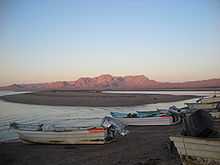Panga (boat)
- This article is about the small watercraft used by commercial fishermen in much of the developing world. See panga for information about the panga fish, and Panga (disambiguation) for others.
The Panga is a type of modest-sized, open, outboard-powered, fishing boat common throughout much of the developing world, including Central America, the Caribbean, parts of Africa, the Middle East, and much of Asia. The original panga design was developed by Yamaha as part of a World Bank project circa 1970.[1][2][3] Pangas are commonly operated directly off of beaches.[4] The name comes from the panga fish which is commonly netted, note the upswept bow of the boat which resembles the machete or knife called a panga. In addition to being used by fishermen, pangas are also popular with Somali pirates.
-

Photo of pangas at Tiburón Island by Steve Marlett.
-

Photo of pangas at La Antigua River, Mexico, by Philo Nordlund.
-

Photo of a panga in the Comoros Islands by M. Wanasimba.
-

A panga used by Somali pirates under observation by the United States Navy.
Key features of the panga design are a high bow, narrow waterline beam, and a flotation bulge along the gunwale, or top edge of the hull. The high bow provides buoyancy for retrieving heavy nets, and minimizes spray coming over the bow. The narrow beam allows the hull to be propelled by a modest-sized outboard motor. The flotation bulge along the gunwale provides increased stability at high angles of roll. These features link the panga design to traditional Japanese wasen fishing boats.
The original Yamaha panga design had a length of 22 feet (6.7 m), and a waterline beam of approximately 5 feet 6 inches (1.7 m). The flotation bulge at the gunwale increased the overall beam to approximately 6 feet 6 inches (2.0 m).
Pangas are usually between 19 and 28 feet (5.8 and 8.5 m) in length, with capacities ranging from 1 to 5 short tons (0.89 to 4.46 long tons; 0.91 to 4.54 t) and powered by outboard motors of between 45 and 200 hp (34 and 149 kW). Their planing hulls are capable of speeds in excess of 35 knots (40 mph; 65 km/h).
The hulls are made of Fiberglass or FRP, heavily reinforced by numerous bulkheads, and usually have bow and stern enclosed flotation compartments.
In the hands of an experienced operator they are considered extremely seaworthy. Most pangas are expected to have a working life of between 5 to 10 years if properly maintained.
References
- ↑ Panga history at Allmand Boats. Retrieved from http://allmandboats.blogspot.com/.
- ↑ Panga history at Microskiff. Retrieved from http://www.microskiff.com/reviews/boats/PangaMarine_18_skiff.html.
- ↑ Panga article at Soundings Online. Retrieved from http://www.soundingsonline.com/features/type-of-boat/178-the-versatile-panga-is-coming-of-age-.
- ↑ Video of a panga landing on a beach in Mexico. Retrieved from http://www.youtube.com/watch?v=uNW0n9PlKGc&feature=related
